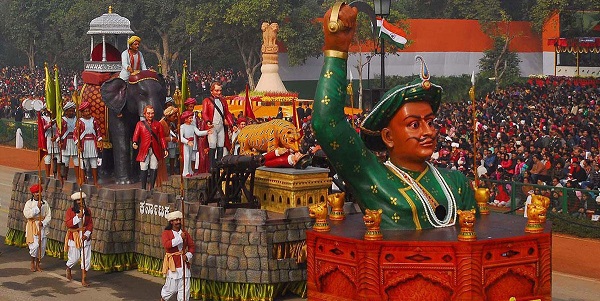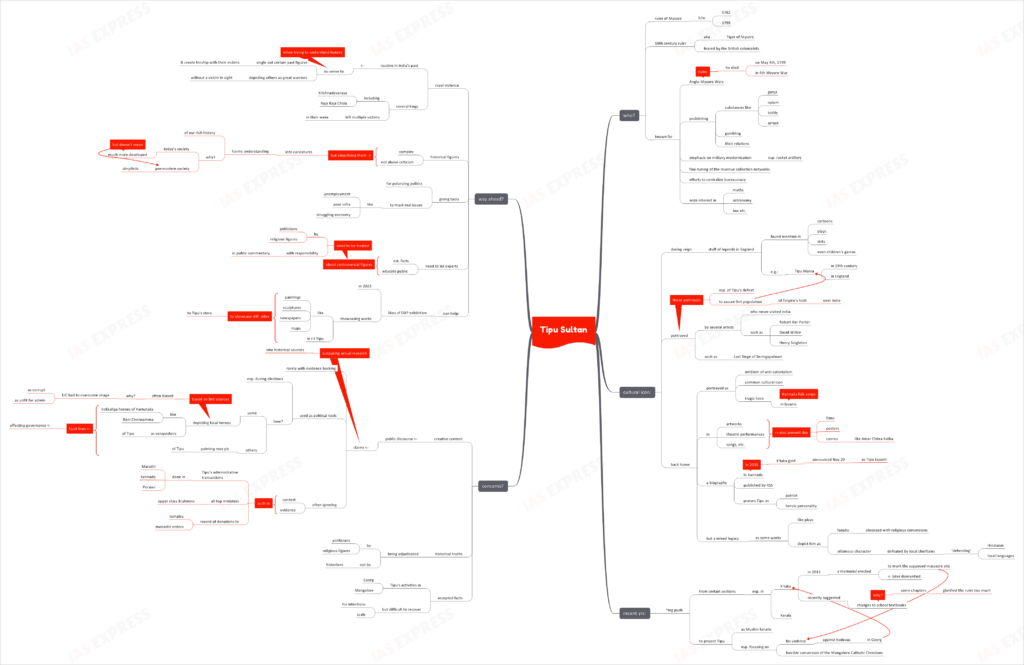Tipu Sultan- His Place in Political & Cultural Discourse

The ghost of Tipu Sultan continues to haunt the politics of Karnataka, with several politicians denouncing him as a religious fanatic, while others profess their adoration for one of the earliest freedom fighters of India.

This topic of “Tipu Sultan- His Place in Political & Cultural Discourse” is important from the perspective of the UPSC IAS Examination, which falls under General Studies Portion.
Who was Tipu Sultan?
- Tipu Sultan was the ruler of Mysore between 1782 and 1799.
- This 18th century ruler was considered the Tiger of Mysore- a figure feared by the British colonialists.
- He is known for his campaigns against the British in the Anglo-Mysore Wars. He died on the battlefield on May 4th, 1799, in the 4th Anglo-Mysore War.
- He is also known for:
- Prohibiting substances like ganja, opium, toddy and arrack
- Prohibiting gambling and illicit relations
- His emphasis on military modernization, especially with regards to rocket artillery
- His fine-tuning of the revenue collection networks
- His efforts to centralize bureaucracy
- His wide range of interests in mathematics, astronomy and law
How much of a cultural icon is he?
- During his period, he turned into a stuff of legends in England. The ruler found his way into cartoons, plays, skits and even children’s games. Eg: 19th century ‘Tipu Mania’ in England.
- Several artists, who had never visited India, such as Robert Ker Porter, David Wilkie and Henry Singleton, portrayed the several historic scenes from his life- such as the Last Siege of Seringapatam.
- The British Empire often produced portrayals of Tipu’s defeat to reassure the British population of the Empire’s stable hold over the crown jewel India.
- Back home too, he became an emblem of anti-colonialism. Mythification had led to Tipu Sultan evolving into a common cultural icon over the years.
- Several lavanis (Kannada folk songs, some dating back to 1800, lament his death. This is especially significant because folk singers rarely existed for the sake of any king in the region. They mainly focused on tragic heroes.
- Artworks, theatre performances and songs focused on Tipu’s pursuits. In late 1970s, even the Rashtriya Swayamsevak Sangh published a concise biography on Tipu (in Kannada) praising him as a patriot and a heroic personality.
- This has continued to present day too in films, posters and other creative representations. For example, the Amar Chitra Katha comics immortalized his bravery against the British.
- However, he has a mixed legacy as a cultural icon. For instance, several plays depict him as a fanatic obsessed with religious conversions- a villainous character who was defeated by local chieftains ‘defending’ Hinduism and local languages like Kannada.
- In 2015, the Karnataka government declared November 20th as Tipu Jayanti.
Developments in Recent Years:
- In the recent years, there has been an increasing push from certain sections to project Tipu as a Muslim fanatic, especially in Karnataka and parts of Kerala. These negative commentary mainly focuses on his violent pursuits against the Kodavas in Coorg, Karnataka and his forcible conversion of the Mangalore Catholic Christians.
- In 2015, several Kodava activists erected a memorial to mark the supposed massacre site. It was later dismantled by the forest department.
- Recently, the Karnataka government suggested making changes regarding Tipu in school textbooks. The government opined that the chapters glorified the ruler too much.
Why is this concerning?
- Over the years, creative content has made its way into public discourse to turn into claims. These have outpaced actual research inquiries into valid historical sources. These claims are rarely backed by any historical sources.
- Such claims are being used as political tools, especially when elections loom close. Politicians have started depicting local heroes (such as the Vokkaliga heroes of Karnataka and Rani Chennamma) as vanquishers of Tipu. On the other hand, opposing politicians have started painting an exceedingly rosy picture of Tipu. This is creating major fault-lines, sometimes at the cost of good governance.
- The British sources depict him as a fanatic from whom the people needed saving. This helped the East India Company overcome the damage to its reputation as a corrupt and unfit organization. Now these biased sources are being used as basis for various politically-charged claims.
- In many of these discourses, historical context is often ignored. In some cases, even research findings from historians are ignored.
- Historians have established that Tipu’s administrative transactions were done in several languages- like Marathi and Kannada, in addition to Persian.
- His top ministers were all upper-class Brahmins.
- There are several records of his donations to Hindu temples and monastic orders in Mysore.
- As a result, politicians and religious figures (instead of historians) are now adjudicating historical truths.
- On the other hand, while Tipu’s violent activities in Coorg and Mangalore are widely accepted facts, recovering his intentions is no simple task. Establishing even the scale of these atrocities is a challenge, given the British colonial sources’ bias with regards to Tipu.
What is the way ahead?
- Royal violence was a routine in India’s past. Several kings, including Krishnadevaraya and Raja Raja Chola, left multiple victims in their wake. Hence, it doesn’t make sense to single out certain past figures and create kinship with their victims, while depicting others as great warriors without a victim in sight, when trying to understand history.
- Historical figures are complex and definitely not above criticism. Simplifying such figures into caricatures of a religious fanatic or a righteous crusader does harm to our understanding of the rich history of India. While it is true that the modern society is far more developed, it doesn’t mean that pre-modern societies were simplistic.
- It is also provides tools for polarizing politics that serve to mask real issues like unemployment, poor state of infrastructure and the struggling economy.
- Meanwhile, it is necessary to let the experts establish facts about such controversial figures and educate the general public. It is vital that political and religious figures handle such topics with responsibility in their public commentary, especially given the divisive climate.
- In 2022, the DAG put together an exhibition, ‘Tipu Sultan: Image & Distance’, to offer an insight into the different perspectives of the Mysore ruler’s legacy. It showcased maps, paintings, newspapers and sculptures capturing instances of Tipu’s life and death. Such attempts to showcase the different sides of the story can help.
Practice Question for Mains:
Comment on Tipu Sultan’s place in modern political and cultural discourse. (250 words)

